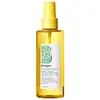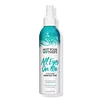What's inside
What's inside
 Key Ingredients
Key Ingredients

No key ingredients
 Benefits
Benefits

 Concerns
Concerns

 Ingredients Side-by-side
Ingredients Side-by-side

Water
Skin ConditioningAloe Barbadensis Leaf Juice
Skin ConditioningCaprylyl/Capryl Glucoside
CleansingPullulan
Sucrose
HumectantMusa Sapientum Peel Extract
Skin ConditioningCocos Nucifera Fruit Extract
EmollientSodium Cocoyl Glutamate
CleansingAnanas Sativus Fruit Extract
Skin ConditioningCitric Acid
BufferingHedychium Coronarium Root Extract
MaskingCurcuma Longa Root Extract
MaskingMangifera Indica Juice
Skin ConditioningOcimum Sanctum Leaf Extract
Skin ConditioningPanthenol
Skin ConditioningGlycerin
HumectantMelia Azadirachta Flower Extract
Skin ConditioningMelia Azadirachta Leaf Extract
Skin ConditioningOcimum Basilicum Flower/Leaf Extract
TonicCorallina Officinalis Extract
Skin ConditioningCarica Papaya Fruit Extract
Skin ConditioningSilica
AbrasiveLactobacillus
Skin ConditioningGlyceryl Caprylate
EmollientPolyglyceryl-6 Oleate
EmulsifyingDehydroxanthan Gum
Emulsion StabilisingEuterpe Oleracea Fruit Extract
Sodium Surfactin
CleansingParfum
MaskingCaprylhydroxamic Acid
Benzyl Alcohol
PerfumingWater, Aloe Barbadensis Leaf Juice, Caprylyl/Capryl Glucoside, Pullulan, Sucrose, Musa Sapientum Peel Extract, Cocos Nucifera Fruit Extract, Sodium Cocoyl Glutamate, Ananas Sativus Fruit Extract, Citric Acid, Hedychium Coronarium Root Extract, Curcuma Longa Root Extract, Mangifera Indica Juice, Ocimum Sanctum Leaf Extract, Panthenol, Glycerin, Melia Azadirachta Flower Extract, Melia Azadirachta Leaf Extract, Ocimum Basilicum Flower/Leaf Extract, Corallina Officinalis Extract, Carica Papaya Fruit Extract, Silica, Lactobacillus, Glyceryl Caprylate, Polyglyceryl-6 Oleate, Dehydroxanthan Gum, Euterpe Oleracea Fruit Extract, Sodium Surfactin, Parfum, Caprylhydroxamic Acid, Benzyl Alcohol
Water
Skin ConditioningCetearyl Alcohol
EmollientBehentrimonium Chloride
PreservativePhenoxyethanol
PreservativeCaprylyl Glycol
EmollientSorbic Acid
PreservativeParfum
MaskingCyclopentasiloxane
EmollientCyclohexasiloxane
EmollientQuaternium-18
Methyl Gluceth-20
HumectantQuaternium-80
Cocodimonium Hydroxypropyl Silk Amino Acids
Skin ConditioningAloe Barbadensis Leaf Juice
Skin ConditioningMacadamia Ternifolia Seed Oil
EmollientHydrolyzed Keratin
HumectantButylene Glycol
HumectantHelianthus Annuus Seed Extract
Skin ConditioningDisodium EDTA
Citric Acid
BufferingWater, Cetearyl Alcohol, Behentrimonium Chloride, Phenoxyethanol, Caprylyl Glycol, Sorbic Acid, Parfum, Cyclopentasiloxane, Cyclohexasiloxane, Quaternium-18, Methyl Gluceth-20, Quaternium-80, Cocodimonium Hydroxypropyl Silk Amino Acids, Aloe Barbadensis Leaf Juice, Macadamia Ternifolia Seed Oil, Hydrolyzed Keratin, Butylene Glycol, Helianthus Annuus Seed Extract, Disodium EDTA, Citric Acid
Alternatives
Ingredients Explained
These ingredients are found in both products.
Ingredients higher up in an ingredient list are typically present in a larger amount.
Aloe Barbadensis Leaf Juice comes from leaves of the aloe plant. Aloe Barbadensis Leaf Juice is best known for helping to soothe sunburns. It is also anti-inflammatory, moisturizing, antiseptic, and can help heal wounds.
Aloe is packed with good stuff including Vitamins A, C, and E. These vitamins are antioxidants, which help fight free-radicals and the damage they may cause. Free-radicals are molecules that may damage your skin cells, such as pollution.
Aloe Barbadensis Leaf Juice also contains sugars. These sugars come in the form of monosaccharides and polysaccharides, folic acid, and choline. These sugars are able to help bind moisture to skin.
It also contains minerals such as calcium, 12 anthraquinones, fatty acids, amino acids, and Vitamin B12.
Learn more about Aloe Barbadensis Leaf JuiceCitric Acid is an alpha hydroxy acid (AHA) naturally found in citrus fruits like oranges, lemons, and limes.
Like other AHAs, citric acid can exfoliate skin by breaking down the bonds that hold dead skin cells together. This helps reveal smoother and brighter skin underneath.
However, this exfoliating effect only happens at high concentrations (20%) which can be hard to find in cosmetic products.
Due to this, citric acid is usually included in small amounts as a pH adjuster. This helps keep products slightly more acidic and compatible with skin's natural pH.
In skincare formulas, citric acid can:
While it can provide some skin benefits, research shows lactic acid and glycolic acid are generally more effective and less irritating exfoliants.
Most citric acid used in skincare today is made by fermenting sugars (usually from molasses). This synthetic version is identical to the natural citrus form but easier to stabilize and use in formulations.
Read more about some other popular AHA's here:
Learn more about Citric AcidParfum is a catch-all term for an ingredient or more that is used to give a scent to products.
Also called "fragrance", this ingredient can be a blend of hundreds of chemicals or plant oils. This means every product with "fragrance" or "parfum" in the ingredients list is a different mixture.
For instance, Habanolide is a proprietary trade name for a specific aroma chemical. When used as a fragrance ingredient in cosmetics, most aroma chemicals fall under the broad labeling category of “FRAGRANCE” or “PARFUM” according to EU and US regulations.
The term 'parfum' or 'fragrance' is not regulated in many countries. In many cases, it is up to the brand to define this term.
For instance, many brands choose to label themselves as "fragrance-free" because they are not using synthetic fragrances. However, their products may still contain ingredients such as essential oils that are considered a fragrance by INCI standards.
One example is Calendula flower extract. Calendula is an essential oil that still imparts a scent or 'fragrance'.
Depending on the blend, the ingredients in the mixture can cause allergies and sensitivities on the skin. Some ingredients that are known EU allergens include linalool and citronellol.
Parfum can also be used to mask or cover an unpleasant scent.
The bottom line is: not all fragrances/parfum/ingredients are created equally. If you are worried about fragrances, we recommend taking a closer look at an ingredient. And of course, we always recommend speaking with a professional.
Learn more about ParfumWater. It's the most common cosmetic ingredient of all. You'll usually see it at the top of ingredient lists, meaning that it makes up the largest part of the product.
So why is it so popular? Water most often acts as a solvent - this means that it helps dissolve other ingredients into the formulation.
You'll also recognize water as that liquid we all need to stay alive. If you see this, drink a glass of water. Stay hydrated!
Learn more about Water